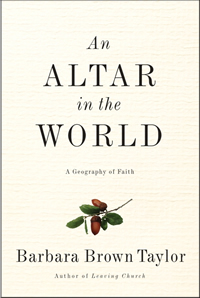Book Notes
 Barbara Brown Taylor, An Altar in the World; A Geography of Faith (New York: HarperCollins, 2009), 217 pp.
Barbara Brown Taylor, An Altar in the World; A Geography of Faith (New York: HarperCollins, 2009), 217 pp.
In her memoir called Leaving Church; A Memoir of Faith (2006), Barbara Brown Taylor told her story of how after ministering for nine years on the staff of a large Episcopal church in urban Atlanta, where she had lived half of her adult life, she moved to Clarkesville in northeast Georgia, a town of 1,500 people and two stoplights. The prospect of serving Grace-Calvary Episcopal with its tiny sanctuary that seated 85 people was a dream come true for her, or so she thought. Her passion and competence spelled success, and after five years the church had expanded to four Sunday services. In the process she nearly lost her soul, and so she resigned, left church, and in 1998 took an endowed chair of religion at nearby Piedmont College. Since then she has lived with her husband on a working farm, become a regular speaker of note on the Christian circuit, and continued to write.
For those who might wonder, Taylor might have left church but she has by no means left the faith, and in this book she self-identifies as a Christian. This is an important point because her newest book is not exactly or particularly Christian. This is not a criticism but a simple observation. One of her goals is to abolish the distinctions we make between church and world, sacred and secular, spirit and flesh, body and soul. Any place or thing can mediate the sacred, and so we can make an altar in the world as well as in the church. Taylor draws upon her Christian experiences and tradition, but she also incorporates her knowledge and expertise from having taught a world religions course at Piedmont College for ten years—the Buddhist Eight-Fold Path, the Muslim notion of pilgrimage, rabbinic wisdom from Judaism, or the Sufi mystic poet Rumi. She uses the word "God," but also a semantic range of synonyms like the Real, the Really Real, the Sacred, the Holy, and the divine More.
From these sources and her own experiences Taylor commends twelve spiritual practices, but to call them "spiritual" can be misleading, for most of all she commends a fleshly, embodied spirituality. She writes one chapter each on vision, reverence, incarnation, groundedness, wilderness, community, vocation, sabbath, physical labor, breakthrough, prayer, and benediction. Taylor's book raised a cluster of interesting questions for me. Does an authentic Christian life look any different than a Muslim or Buddhist or deeply spiritual atheist? Should it? Beyond obvious similarities, what are the significant differences? People who follow these twelve spiritual practices will live richer lives, and if that's the case then what, exactly, does the Gospel offer them? More of the same, or something that they cannot hope for anywhere else? I appreciate whatever intention Taylor had to write a "cross-over" book to people who want to be spiritual but not religious, but in the end I wondered if this was just another self-help book by a deeply Christian pilgrim. "Welcome to your own priesthood," she says in her introduction, "practiced at the altar of your own life."


